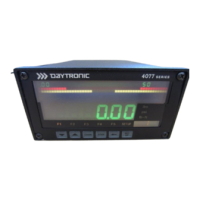course, you will enter "0"). Then press the STEP button to display
Channel 1's "F1" parameter.
5. Apply a second
accurately known
value of input loading—a value
(positive or negative) from 80% to 100% of the transducer's
nominal full-scale rating.
6. Now enter the numerical value of the second known input, with
appropriate polarity. This "forces" the channel's data reading to
equal this value, thereby determining the SCALING FACTOR to be
applied to all subsequent channel readings.
NOTE: This entry also sets the desired
precision
for Channel 1. If,
for example, you're measuring "pounds," and enter an "F1" of
"100," then all subsequent readings will be rounded to the nearest
pound. If "F1" is "100.0," then all readings will be rounded to the
nearest
tenth
of a pound. This same precision will be automatically
reflected in Channel 1's "limit-zone" parameters: "LEP," "LLL,"
"LOL," "HIL", "HHL," and "HEP" (see Section 2.h).
7. Exit "SETUP" mode by pressing the SETUP button.
2.10
2.e Channel Calibration

